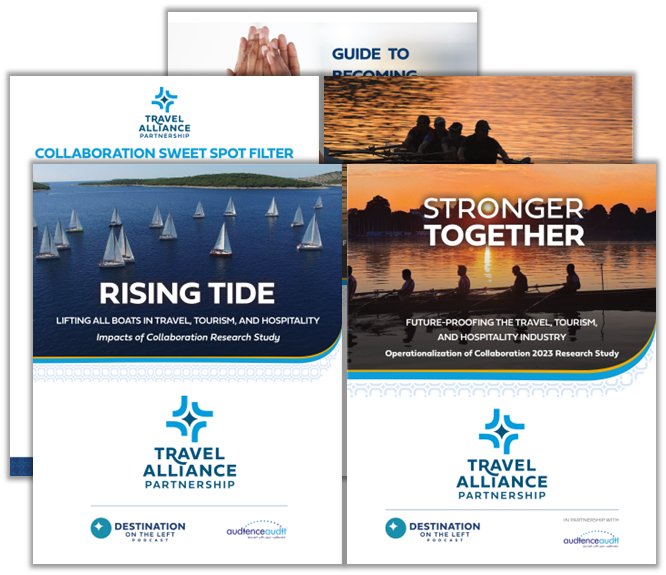Storytelling is Key in Tourism Marketing
In a world filled with stunning travel photos and packaged itineraries, what truly inspires someone to book a trip? It’s not just the picture-perfect landscapes or the extensive list of amenities your destination offers – it’s the stories behind them.
The stories of a solo traveler finding connection in a bustling local event, of a local guide revealing generations of tradition, of a family rediscovering each other around a campfire. These are the moments that linger long after the suitcase is unpacked.
That’s the power of storytelling in tourism marketing. It doesn’t just showcase what a place looks like; it invites people to imagine how it might feel. When you create that emotional spark, you build relationships that will continue to grow for years to come.

Why Storytelling Matters
While we often focus on the logistics behind travel decisions, it’s important to remember that travelers are driven by emotion. People are moved to action when a story sparks curiosity, joy, nostalgia, or a sense of belonging. That emotional connection builds loyalty, increases engagement, and drives real results, from clicks and conversions to return visits.
Where traditional marketing shows, storytelling immerses. It connects audiences with characters, grounds them in a sense of place, and lets them envision themselves in the journey.
What Makes a Great Travel Story?
If you think back to English class, you might remember the storytelling basics: character, setting, conflict, resolution, and theme. Surprise! Similar elements make for powerful travel marketing, too.
The best tourism storytelling is rooted in authenticity and shaped by structure. A compelling travel story often includes:
- A Strong Character. Real people with relatable experiences, such as locals, visitors, or business owners.
- A Vivid Setting. Descriptions that transport the audience and paint a picture of place.
- Conflict and Resolution. Whether it’s the transformation of a visitor or the evolution of a community, stories thrive on change.
- Emotion. Joy, curiosity, nostalgia, surprise—good stories spark genuine emotion.
- A Purpose. Every story should support a larger message: why your destination matters.
You don’t need a plot twist worthy of a novel, but grounding your content in these classic storytelling elements will help audiences connect more deeply and remember you longer.
Storytelling in Action
When Arlington Convention & Visitors Service set out to shift perceptions beyond Arlington National Cemetery, Travel Alliance Partnership helped shape a brand story that highlighted the area’s vibrant neighborhoods, cultural experiences, and community character. Story-first tactics like influencer partnerships, immersive media kits, and targeted PR led to millions of impressions and a more well-rounded, emotionally resonant destination identity.
Similarly, the Haunted History Trail of New York State needed to overcome a seasonal challenge. Known primarily for fall travel, the trail’s narrative was expanded through year-round storytelling. By leaning into thematic content, media outreach, and an engaging visual guide, we helped reframe the trail as a compelling experience in every season, earning national media coverage and increasing off-season interest.
These campaigns prove what a strong narrative can do: change perception, deepen engagement, and drive measurable tourism growth.
How to Start Storytelling for Your Destination
If your content strategy is currently focused on static listings or promotional language, weaving in storytelling can set you apart. Here are a few ways to begin:
Highlight Local Voices
Interview residents, artisans, chefs, historians, or community leaders. Their stories embody the spirit of your destination.
Document a Visitor’s Journey
Follow a traveler’s experience through your region, from first impressions to favorite discoveries.
Show Seasonal Shifts
Capture how your destination transforms throughout the year through personal or community narratives.
Use Testimonials as Mini-Stories
Turn a simple review into a compelling quote paired with imagery, video, or a short blog.
Storytelling Formats That Drive Engagement
There’s no one-size-fits-all approach to storytelling content. In fact, the more you diversify your formats, the more opportunities you can meet audiences where they are. Consider:
- Short-form video. Behind-the-scenes tours, day-in-the-life local profiles, or first-person adventures.
- User-generated content. Amplify stories already being told by travelers who love your destination.
- Narrative blog posts. Go beyond listicles and share experiences with depth and emotion.
- Podcast segments or audio clips. These are especially effective for cultural storytelling or historical interpretation.
When travelers connect with a place through people, culture, and emotion, they’re more likely to remember it, talk about it, and return to it. Whether you’re highlighting a hidden gem or reintroducing a well-known spot, leading with a good story can make all the difference.
If you’re curious about how storytelling could enhance your destination’s marketing, we’re always happy to share ideas, examples, or just have a conversation.
Author
Related Posts
Welcoming All 2.0: Key Takeaways from Our Community Conversation on Inclusion in Tourism
In our rapidly evolving travel industry, the concept of being a “welcoming destination” is no longer simply about inviting more visitors. It’s about deeply understanding…
10 Must-Listen Podcasts for Travel, Tourism & Hospitality Professionals
I’ve had the joy of hosting Destination on the Left—an award-winning podcast spotlighting the travel, tourism, and hospitality industry—since 2016. My team and I believe…
